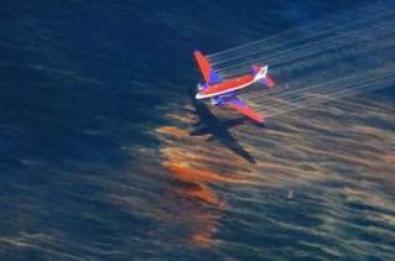
BP sprays more chemicals into main Gulf oil leak
By Harry R. Weber and John Curran AP
Crews using the deep-sea robot attempted to thin the oil — which is rushing up from the seabed at a pace of about 210,000 gallons per day — after getting approval from the Environmental Protection Agency, BP spokesman Mark Proegler told The Associated Press.
The agency had halted two previous rounds of the dispersant to test its potential impact on the environment, and approved a third round of spraying that began early Monday, Proegler said.
The EPA said in a statement the effects of the chemicals were still widely unknown.
BP engineers, casting about after an ice buildup thwarted their plan to siphon off most of the leak using a 100-ton containment box, pushed ahead with other potential short-term solutions, including using a smaller box and injecting the leak with junk to plug it. However, none of these has been tried so deep — about a mile down. Workers were simultaneously drilling a relief well, the solution considered most permanent, but that was to take up to three months.
At least 3.5 million gallons were believed to have leaked since an April 20 drilling rig blast killed 11. If the gusher continues unabated, it would surpass the Exxon Valdez disaster as the nation's worst spill by Father's Day.
The engineers appear to be "trying anything people can think of" to stop the leak, said Ed Overton, a LSU professor of environmental studies.
Back on land, National Guard helicopters ferried loads of 1-ton sandbags to plug gaps in barrier islands that have been lapped at by a sheen of oil. The effort to bolster the islands was meant to safeguard the area's vulnerable wetlands.
Authorities also planned to use south Louisiana's system of locks and levees to release water to help keep the worst of the oil at sea.
"We're trying to save thousands of acres of marsh here in this area, where the shrimp lay their eggs, where the fin fish lay their eggs, where the crabs come in and out," said Chett Chiasson, executive director of the Greater Lafourche Port Commission. "We're trying to save a heritage, a way of life, a culture that we know here in recreational and commercial fishing."
BP — which is responsible for the cleanup — said Monday the spill has cost it $350 million so far for immediate response, containment efforts, commitments to the Gulf Coast states, and settlements and federal costs. The company did not speculate on the final bill, which most analysts expect to run into tens of billions of dollars.
Among plans under consideration for the gusher, BP is looking at cutting the riser pipe, which extends from the well, undersea and using larger piping to bring the gushing oil to a drill ship on the surface, a tactic considered difficult and less desirable because it will increase the flow of oil.
Above the oil leak, waves of dark brown and black sludge crashed into the support ship Joe Griffin. The fumes there were so intense that a crew member and an AP photographer on board had to wear respirators while on deck.
Oil — be it a surface sheen, globules or balls of tar — has washed up west of the Mississippi River and as far east as Dauphin Island, three miles off the Alabama mainland at the mouth of Mobile Bay.
The blowout aboard the rig, which was being leased by BP, was triggered by a bubble of methane gas that escaped from the well and shot up the drill column, expanding quickly as it burst through several seals and barriers before exploding, according to interviews with rig workers conducted during BP's initial, internal probe. The exact cause remains under investigation.

